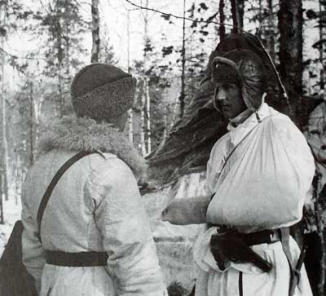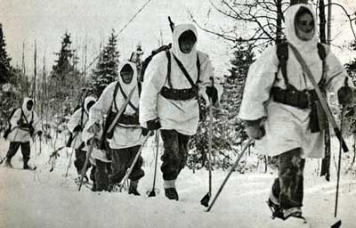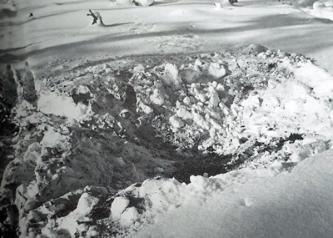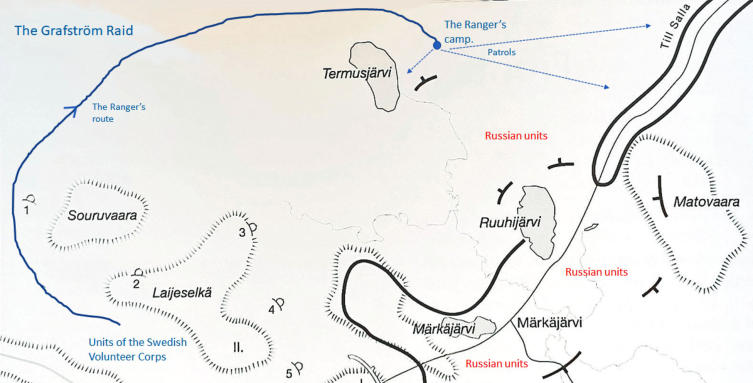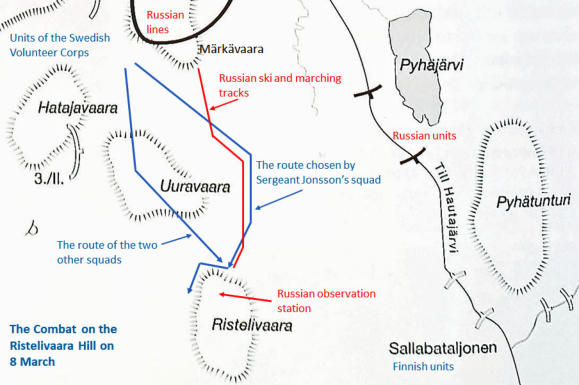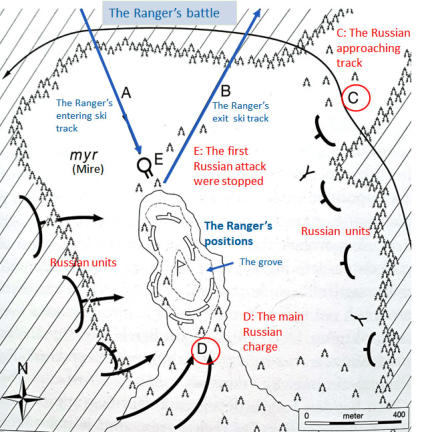

Copyright © Hans Högman 2021-01-19
The Swedish Volunteer
Corps in Finland - 3
Swedish Volunteer Corps in
Finland - The Battles
The Swedish Volunteer Corps (SVC) was involved in
many battles with the Russian forces in Märkäjärvi
after the Swedes took over the front sector from the
Finns.
Below is a selection of battles or combats the SVC
was involved in:
Lieutenant Colonel Magnus Dyrssen - Killed
in Action on 1 March 1940
On 1 March 1940, the Commander of the I.
Battlegroup, Lieutenant Colonel Magnus Dyrssen,
was reviewing the Corps defense area, fieldwork, fire
positions, etc. The Swedes were that day bothered
by Russian air raids. At 15:00, Russian artillery
batteries opened fire onto the position of the I.
Battlegroup. Lieutenant Colonel Dyrssen was hit by
a piece of shrapnel and died. Senior Company
Commander of the I. Battlegroup, Captain Carl
C:son Bonde, took over the Command of the
battlegroup.
The Ranger Company’s Combat on 2 March
1940
On 1 March 1940, the Ranger Company with the II.
Battlegroup received an order to execute a three-
day-long reconnaissance commission behind the
Russian lines in Märkäjärvi. The objective was to
explore the land and to find a possible line of
approach for a northern attack on the Russian
positions in Märkäjärvi. Commander of the Ranger
Company was Lieutenant Anders Grafström. The
company consisted of 168 army rangers, however,
only 93 rangers were selected for the mission since
one of the platoons been on an exhausting
reconnaissance and surveillance commission during
the previous night and needed a recovery.
Ammunition, a communication radio, two squad
tents with stoves (each tent had room for 25
soldiers), and vacuum-packed provisions were
packed in two one-man pulled sleds, which the
rangers took turns to pull. Further, two more sleds
were brought for the transportation of wounded
rangers, if any.
Under the cover of darkness, the Ranger Company
departed at 17:00 (5:00 PM) on skis. The
temperature was then -20 degrees C (-4 F).
The company took a wide circular route west of the
Russian positions and entered behind the Russian
defense line from the north. After a nine-hour
exhausting ski march, with only short breaks, the
company pitched a camp in total darkness in a
forested area close to the Russian lines. Guards
were posted in all directions and the two squad
tents were pitched for a few hours of sleep with 35 -
40 rangers per tent. Food was heated for energy.
Early, at 3:00 in the morning, still dark,
reconnaissance patrols were sent out to determine
their present situation. The patrols returned with
valuable information about the Russian positions,
type of units,
activities, etc.
The image to the
right shows a
Swedish
reconnaissance
ski-patrol in
Finland during
the Winter War.
At first light, the Swedes found out that they, in the
darkness of night, had pitched their camp in a larger
grove surrounded by open country.
One patrol got into trouble:
One of the patrols, consisting of nine men under
the command of Second Lieutenant Torbjörn Öjstad,
ended up in a Russian ambush with some 60
Russians. The rangers in the patrol were exhausted
after the tiring night and Second Lieutenant Öjstad,
against rules, decided to return to the company’s
camp in the own ski tracks, which was less
exhausting than skiing in the deep snow. This turned
out to be a fatal mistake. However, two rangers
made a protest and they took another way back,
which saved their lives; they were First Sergeant Åke
Edsbo and private Jonas Johansson.
The remaining seven rangers in the patrol skied
used their old ski tracks and ended later in an
ambush where 60 Russians lay in wait. In the hour-
long losing combat following, Second Lieutenant
Öjstad, Sergeant Bror Sixten Jansson, and private
Linus Johansson were killed. The remaining four
rangers, of which two were wounded, were taken
prisoners of war. One of the wounded Swedes,
Sergeant Per-Gustaf Carlsson, died a few hours
later.
The two in the patrol that took another route
managed to get back to the company camp without
any contact with Russians. The three Swedish POWs
survived the Russian captivity and were able to
return to Sweden in May 1940, after the Winter War;
they were First Sergeant Nils Wikström, Sergeant
Torsten Jonsson, and private Uno Bengtsson.
The fallen Swedes in the ambush weren’t found until
August 1940, i.e. after the war, by First Sergeant
Wikström. The Russian soldiers had rigged mines
around the killed Swedes, so-called booby-traps.
The ranger’s combat in the Grove on 2 March:
Around 13:00 on 2 March, a Russian force of 60
soldiers on skis approached the grove where the
ranger’s base was. The Russians discovered the
Swedish entering ski track into the grove, which was
on the north side of the grove, and then advanced
towards the grove. The Swedes opened fire and
long combat broke out. Yet another troop of 70
men joined the Russian force and the new troop
attacked the Swedes from the south. However, the
Swedish rangers had a very good defensive position
in the slightly elevated grove and managed to repel
the Russian attacks and the Russians suffered from
great losses. The rangers also had wounded soldiers
and casualties. The Russian force received
reinforcements and their force counted 400 men
after a while. However, it was difficult for the
Russians to fire from prone positions in the deep
snow and their firing was often too highly aimed.
The Russian attempts to conquer the grove came to
a halt around 14:30 (2:30 PM). Around 15:00 yet
another troop of 50 - 60 Russians arrived and at
16:30 another 150 men. The Russians regrouped for
attacks from both the west and the south.
The Swedish rangers made several attempts to
contact their headquarters but the radio wasn’t
functional in the cold weather.
The Swedes were getting ready for the final Russian
charge which was initiated at 18:00. The main
Russian charge came from the south. The Swedish
machine guns caused severe Russian losses. A
Swedish violent counter-attack, commanded by
Lieutenant Sven Grape, developed into close
quarter combat which went on into the Russian
assembly area. The counter-attack was very
successful and the Russian unit was wiped out. It
was estimated that the Russians lost between 100
and 200 men in the battle.
The Swedish company lost six rangers in the
battle and several rangers were wounded. The killed
Swedes were: First Sergeant Evald Hjukström, First
Sergeant Gunnar Hörnqvist, First Sergeant Olof
Svensson-Myhr, Sergeant Helge Wallman, private
Jonas Johansson, and private Algot Palm.
Under the cover of darkness, the Swedish rangers
then made an eastward breakout from their base
in the grove since this direction was where the
Russian was weakest. The severely wounded
Rangers were put in the sleds while the lightly
wounded were capable to ski. Captured Russian
weapons were also brought forth. However, the six
fallen rangers had to be left behind in the grove as
well as the tents. The breakout was successful.
The Swedes had taken six Russian POWs during the
battle. During the ski march back to the Swedish
lines the Russians were incapable of keeping up with
the rangers why they had to be eliminated.
The order of the ski march was: vanguard, company
HQ, sleds’ with the wounded and Russian weapons,
and the rearguard.
After about 1 km skiing eastward, the rangers
turned north. Then, after a while, they turned
westward and rounded the Russians and skied on a
circular route back to the Swedish lines. The rangers
stopped for a break after 7 hours to have some hot
food and water. This was their first meal for 19
hours in the -30 C (-22 F) cold weather.
The image to the right
shows the
Commander of the
Ranger Company, II.
Battlegroup,
Lieutenant Anders
Grafström, (to the left)
talking to Lieutenant
Sven Grape (left arm in
a sling). Photo:
Krigsarkivet.
The rangers arrived at the Swedish lines without any
further encounter with Russians at 09:00 on 3
March. The rearguard, under the command of
Sergeant Tall von Post, didn’t return at the Swedish
lines until afternoon the following day, after a night
in the open air.
On 20 March, i.e. after the end of the war, the
company skied to the grove to fetch the fallen
rangers.
The ranger’s mission and battle behind the Russian
lines are known as the “The Grafström Raid”.

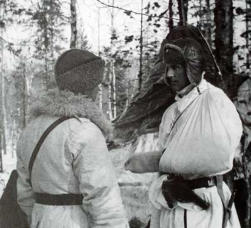
Above, a map of the Ranger Company’s raid behind
enemy lines on 1 - 3 March 1940 with my notes in
color. Image source: The book "För Finlands frihet:
Svenska frivilligkåren 1939-1940 (von Schmidt-
Laussitz)" and shown with the consent of the author.
The Ranger Company, I. Battlegroup –
Second Lieutenant Jervant’s Reconnaissance
Patrol 6 - 7 March
After Lieutenant Grafström’s reconnaissance for a
line of approach for a northern attack of the Russian
positions in Märkäjärvi, there was also a need to find
out the possibilities for a southern line of approach.
A platoon from the Ranger Company with the I.
Battlegroup received an order on 6 March for such
a mission. The reconnaissance patrol consisted of 30
rangers under the command of Second Lieutenant
Arne Jervant. The platoon departed on skis at 21:00
on 6 March 1940 under the cover of darkness and
was instructed to be back around 24:00 on 7 March.
The temperature was then -20 degrees C (-4 F).
An hour before the patrol was leaving, Second
Lieutenant Jervant received information that
Lieutenant Melcher Wernstedt was joining the
patrol. Lieutenant Wernstedt was an HQ adjutant
who had volunteered to join the patrol for the
purpose of study without any power of command.
During the night on 7 March, the patrol approached
the frozen Lake Pyhäjärvi. They entered the ice and
followed the lake’s western side in a northerly
direction. At dawn, they left the northern shore and
entered into bushland where they were less exposed.
The patrol was then challenged by a Russian sentry,
close to the Swede’s present location. In front of the
patrol were rangers Carl-Erik Winlöf and Bror
Strandkvist. Both prepared to open fire at the
Russian sentry when they were stopped by
Lieutenant Wernstedt for some reason. The Russian
sentry was, therefore, able to open fire before the
Swedes. In the firing private Winlöf was badly
wounded in his thigh, probably by an explosive
bullet. The Russian sentry was shot by First Sergeant
Gösta Borg.
The patrol withdrew a few hundred meters to get out
of range and a medic was able to examine Winlöf’s
wound. However, he was losing blood very fast and
the medic reported that Winlöf would bleed to death
if he wasn’t treated by a surgeon within a few hours.
The patrol hadn’t brought any sleds which meant it
would be very difficult to carry Winlöf back to their
own lines before he died. Besides, he was getting
weaker by the minute. The rangers tried to makeshift
a stretcher with connected skis, without succeeding.
Winlöf urged the rangers to leave him and reach
safety. The commander of the patrol, Second
Lieutenant Jervant ordered the patrol to withdraw a
few kilometers towards the road. Jervant and
Lieutenant Wernstedt stayed with Winlöf until a
Russian unit advanced towards them and opened
fire. Jervant gave the order to withdraw. However,
Wernstedt didn’t follow the order and stayed with
private Winlöf. What really happened thereafter was
for a long time unknown. Unfortunately for the SVC,
Wernstedt had, against given orders, brought a map
of the Swedish positions in Märkäjärvi, that now fell
into the hands of the Russians.
All this coincided with the report Second Lieutenant
Jervant made after the
mission the same
evening.
The image to the right
shows Second Lieutenant
Jervant (in white) with a
few of the army rangers in
his platoon.
Jervant managed to get
back to his ranger patrol without any further
incidents. They were still behind enemy lines and a
large Russian unit was advancing towards them, so
Jervant estimated that they would have very little
chance of proceeding with their mission. The patrol,
therefore, aborted the mission and returned to their
own lines.
It was later shown that Lieutenant Wernstedt
deliberately stayed with private Winlöf facing the
consequences of his act when he prevented Winlöf
from opening fire at the Rusian sentry and thereby
indirectly caused Winlöf mortal wound.
On 19 March, i.e. a few days after the end of the war,
the Rangers searched for the bodies of Wernstedt
and Winlöf in the area where the patrol’s combat with
the Russians stood. Both bodies were found, stripped
of all clothes except the underwear.
It seems like Lieutenant Wernstedt had ended dying
Winlöf’s life and then taken his own life to avoid
being captured by the Russians. Both were shot in
the head.
A diary, written by one of the participating rangers,
states that there had been conflicts between
Wernstedt and Jervant during the reconnaissance
mission. They had argued about the route chosen
and Wernstedt had interfered in Jervant’s exercise of
command although Wernstedt had no power of
command in the patrol. There is also a notation in
the diary stating that the rangers, when they were
withdrawing from the area, heard two gunshots.
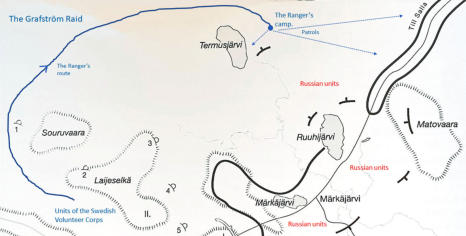

Above, a map showing the route chosen by the
Ranger patrol on 6 - 7 March 1940 with my own notes
in color. Image source: The book "För Finlands frihet:
Svenska frivilligkåren 1939-1940 (von Schmidt-
Laussitz)" and shown with the consent of the author.
The Combat on the Ristelivaara Hill, 8 March
The situation in front of the Swedish Volunteer Corps
southern flank wasn’t satisfactory. The area was
controlled by the Russians via a surveillance unit on
top of the Ristelivaara Hill’s northern summit,
nicknamed “Kalotten” (The skull-cap). From the
summit, the Russians had a full view of the area
south of the I. Battlegroup’s right flank and were able
to monitor everything that happened in this area. The
Russians also had an artillery fire control station on
the summit where forward fire controllers were able
to direct their artillery fire at targets in the low-laying
terrain nearby the Swedish positions.
To launch an attack on the Russian positions in
Märkäjärvi from a southern direction, the Swedes
first had to eliminate the Russian observation spot on
the summit.
The Finnish units had previously tried to conquer the
hill without succeeding.
The Swedish Corps HQ decided to attack and
eliminate the Russian observation spot on the
summit with Lieutenant Grafström’s Ranger
Company, I. Battlegroup, and the 3rd Rifle Company
with the II. Battlegroup under the command of
Captain Herbert Ling-Vannerus.
After midnight on 8 March, a reconnaissance
platoon under the command of Lieutenant Gustav
Söderblom was sent out to monitor the Russian
positions and fortifications on the hill. The platoon
was composed of soldiers from the 3rd Rifle
Company, II. Battlegroup. The platoon, which
consisted of three squads, approached the
Ristelivaara Hill from the north. Two squads skied on
a ski track previously made over the Uuravaara Hill
down to the bottom of the Ristelivaara Hill.
The third squad, under the command of Sergeant
Jonsson, skied on a route between Märkävaara and
Uuravaara to find out if any Russian patrol activities
had been going on in the area during the last 24
hours. They spotted ski tracks between the Russian
positions in Märkävaara and Ristelivaara which
showed that the Russians had been frequently used
these tracks.
The three Swedish squads converged at the bottom
of the Ristelivaara Hill’s north side. Two squads were
to secure the area by the Russian ski track and act as
a reserve while a third squad under the command of
Sergeant Carl Anders Jonsson and six men were
going to advance to the top of Ristelivaara Hill to
locate the Russian unit at the observation spot. The
squad began the ascent to the top of the hill around
7:00 in the morning. They were facing daylight
halfway up on the hill. During their ascent, they
received orders to engage the Russian unit.
When the squad approached the summit they were
dazzled by the rising sun. Therefore they had to move
to the side to get away from the bright sun. The final
approach to the summit had to be done in open
terrain. At 7:30, the squad was spotted by the
Russian sentries and was intensely fired at, from
three different fire positions.
Private Per-Johan Lindh was badly wounded by an
explosive bullet that tore his right forearm to pieces.
Sergeant Carl Anders Jonsson managed to sweep the
closest Russian fire position with his sub-machine-
gun which gave the Swedes breathing space. That
gave private Johan Bergman time to get into a firing
position with his light machine gun and open
supporting fire. Thereby were the other four soldiers
in the squad able to advance and secure their fellow
squad members retreat. Private Jan Henrik
Thegerstöm was then hit by a Russian bullet and fell.
However, private Oskar Inge Fors managed, despite
the heavy Russian fire, to crawl up to Thegerstöm but
could only state that he was already dead.
The open terrain and the heavy Russian firing made it
impossible to launch a counter-attack and the squad
was forced to retreat. They were forced to leave
Thegerstöm’s dead body behind but it was fetched a
week later after the
cease-fire on 13
March.
The image to the
right shows the
typical hilly country
in the Märkäjärvi
area. Photo:
Krigsarkivet.
After the combat, Captain Herbert Ling-Vannerus
recommended a distinction to Sergeant Carl Anders
Jonsson and private Per-Johan Lindh for shown great
bravery and resolution during the combat.
Later on the same day, Colonel Nordenswan briefed
the commanders of the I. and II. battlegroups that
larger attack on the Russian position on the
Ristelivaara Hill was to be launched early morning
on 11 March and that they were to prepare the two
battlegroups for such an attack.
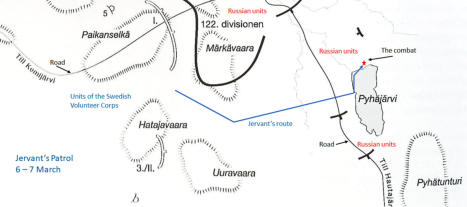
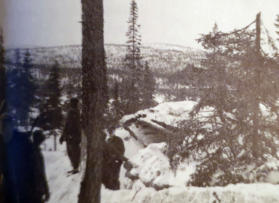
A map outline of Lieutenant Grafström’s battle in the
grove on 2 March 1940 with my notes in color.
Image source: The book "För Finlands frihet:
Svenska frivilligkåren 1939-1940 (von Schmidt-
Laussitz)" and shown with the consent of the author.
Map of the combat on the Ristelivaara Hill where the
Russians had an observation station.
The Finnish word “vaara” means mountain or hill.
Image source: The book "För Finlands frihet:
Svenska frivilligkåren 1939-1940 (von Schmidt-
Laussitz)" and shown with the consent of the author.
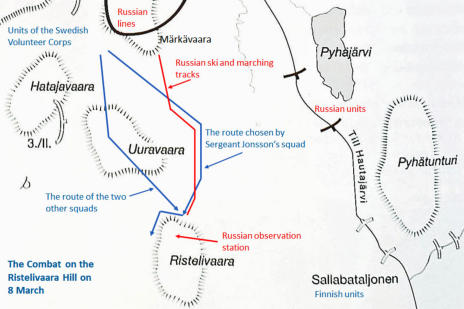
The Russian Attack on 10 March
On 10 March, the preparations for an attack on the
Russian observation spot on the top of the
Ristelivaara Hill were in full progress, which was to be
launched early morning following day.
Reconnaissance had shown that the Russian unit on
the summit numbered about 10 men and that there
were further units, with an unknown force, nearby
the hill.
The Swedish units that were going to carry out the
attack were ordered to deploy at their restrictive final
assault positions at 04:30 in the morning of the
following day. The assault was set off with artillery
fire at the observation spot on the summit.
However, the assault was never carried out on 11
March, since the Russians launched an attack on
the Swedish positions in Märkäjärvi in the
afternoon of 10 March.
At 14:15 on 10 March, the machine gun troop, 2nd
Rifle Company, II. Battlegroup, gave the alert signal
about an imminent Russian assault at the Rifle
Company’s right flank. The Swedish units were
immediately ordered to their battle positions. When
a smaller Russian unit advanced to about 100 meters
from the hindrance line the machine gun troop
opened fire and the Russian assault came to a
standstill. At 15:00, a larger Russian unit was inserted
in the combat and the assault was intensified.
However, the Swedes repelled also this assault. At
17:00, a new Russian assault was launched, this time
with covering fire from artillery pieces and mortars,
at this sector of the front.
The Swedish mortar troops had their registration
spots for the firing and when they opened fire at the
advancing Russians it had a very good firing effect.
At 20:15, a platoon of army rangers, II. Battlegroup,
was sent out to make a counter-attack at the Russian
right flank which they carried out at 22:00 under the
cover of darkness. Fifteen minutes later, a Swedish
reconnaissance ski patrol was sent out to establish
whether the Russians remained in the terrain in front
of the Swedish positions. The patrol returned at
midnight and was able to report that the Russians
had withdrawn.
During the battle, 46 Russians were killed or
wounded and they had been left behind to die in the
-40 degree C (-40 F) cold weather when the Russian
force withdrew. In the daylight of the following day,
tracks of blood showed that several wounded
Russian soldiers had been dragged back to the
Russian lines too.
At 04:00, the Swedes sent out patrols with sleds to
gather the weapons left behind by the Russians
when they withdrew, which was a lot.
In the morning on 11 March, reports arrived from
the Finnish Salla Battalion about a new Russian unit
around the Ristelivaara Hill. The Salla battalion was
deployed near the Pyhätunturi Hill, i.e. south of the
Russian lines, east of the Ristelivaara Hill. The
Swedish Volunteer Corps sent out several
reconnaissance patrols to find out more about the
new Russian unit’s activities. The patrols didn’t find
any unusual activities in the area. However, the
patrols were able to confirm that the former Russian
units had been relieved by new ones.
The Corps Headquarters reported on 11 March that
the 1st Rifle Company with the III. Battlegroup,
under the command of Captain Victor Ancarcrona,
was arriving in Märkäjärvi during the upcoming night.
This was the first unit with the III. Battlegroup to
arrive at the front sector. The I. and II. battlegroups
had been at the front since 26 February.
It had taken a much longer time to form the III.
Battlegroup. One reason was that the two
battlegroups at the front constantly picked men from
the III. Battlegroup to fill their gaps in the ranks. The
remaining units with the III. battlegroup was planned
to arrive at the front during the nights of 13 – 14
March and 14 – 15 March.
At noon on 12 March, reports arrived from the I.
Artillery Battery’s observation spot on the top of the
Hatajavaara Hill that 10 to 15 Russian tanks been
observed east of Märkäjärvi, heading towards
Märkäjärvi. The Russians were obviously up to
something.
On 12 March, there was a change of command of
the I. battlegroup. Lieutenant Colonel Carl-Oscar
Agell then replaced Captain Carl Bonde, who until
now had been acting commander of the battlegroup.
On 12 March, the 16th Independent Ranger
Company under the command of Captain Gösta
Wetterhall arrived at the front. Another unit that
arrived that day was the 2nd Anti-tank Platoon.
Also, on 12 March, the Russian artillery batteries
showered the I. Battlegroup’s advanced defense line
on the Paikanselkä Hill with shells. The I.
Battlegroup’s Ranger Company was deployed on the
hill.
On the evening of 12 March, a Russian unit of at
least 50 soldiers advanced towards the 2nd Rifle
Company’s left flank and an exchange of fire
occurred. At 18:45, there were also reports from the
3rd Rifle Company, II. Battlegroup, which was
deployed south of the Hatajavaara Hill, i.e. south of
the I. Battlegroup’s positions, that a strong enemy
force was advancing from a southerly direction. The
3rd Rifle Company opened fire. The Ranger Company
with the I. Battlegroup was sent down to the area to
reconnoiter and to establish whether it was a
Russian advance or just a short engagement. It was -
30 C (-22 F) and a moonlight night. Once in the
designated area, the ranger company sent out three
reconnaissance patrols to watch out for Russian
units. At midnight, the rangers sent a report that the
area was quiet and that the Russians had returned to
their lines.
Late in the evening on 12 March, the I. Battlegroup
received orders to send out squads to capture
Russian soldiers to establish which type of Russian
units that now was in the area. The II. Battlegroup
was ordered to carry out reconnaissance in the area
north of the Russian positions in Märkäjärvi. Further,
the battlegroup was to make it difficult for Russian
reconnaissance patrols and disturb the traffic on the
road east of Märkäjärvi and capture Russians to
establish the type of units. The 16th Independent
Ranger Company was sent out on a similar mission. A
Russian unit was detected by the patrols in the sector
in front of the I. Battlegroup’s positions and the
battlegroup was ordered on combat alert.
The Last Battle - The morning of 13 March
On 12 March 1940, Finland and the Soviet Union
signed a Peace Treaty in Moscow which ended the
Winter War with a cease-fire at 11:00 on 13 March
(Helsinki time).
The Headquarters with the Swedish Volunteer
Corps received information in the early morning of
13 March about the peace treaty with a cease-fire in
effect from 11:00. The HQ wasn’t able, at that time, to
get the information confirmed, so only the high
ranked Commanders of the two battlegroups were
informed. The units were briefed at 10:30 about the
imminent armistice.
The Russian units at the Märkäjärvi front ought to
have received similar information that morning from
their HQ.
However, around 6:00 in the morning, 13 March,
the Russians launched a fierce firing at the Swedish
lines in Märkäjärvi with machine guns, artillery,
mortars, and bombers. The showering of the
Swedish lines went on without any breaks for 5
hours.
The Russian firing was repelled by the Swedish
artillery pieces and infantry mortars and at least one
Russian battery was eliminated. The air raids were
battled with automatic anti-aircraft guns and anti-
aircraft machine guns.
Although the intensity, the Russian firing wasn’t
causing too many damages. The deep snow
effectively cushioned the shocks of the points of
impact and the bursts.
The Russian firing stopped at 11:11.
During these last hours of the Winter War, 10
soldiers with the Swedish Volunteer Corps were
killed and 30 were wounded.
The image to the
right shows the
point of impact of a
Russian shell in the
deep snow at the
Märkäjärvi front
sector on 13 March.
Photo: Krigsarkivet.
Since the
Commanders of the Swedish Volunteer Corps in the
early morning of 13 March knew about the cease-fire
at 11:00, also the Russian Commanders at the
Märkäjärvi front ought to have received the same
type of information. After all, they stopped the firing
just after 11:00.
So, why did they launch the fierce firing at the
Swedish lines just a few hours before the cease-fire
took effect? Did they want to use up all their
remaining ammunition or did they want to cause as
much damage as possible before the armistice?
After the cease-fire, the Russian units were
supposed to withdraw from Finnish territory
according to the peace treaty. However, this took
many days, a longer time than agreed. The Swedish
Volunteer Corps, therefore, remained in their
positions, with surveillance, and the monitoring of
the Russian withdrawal as long as there were Russian
units in the area. On 23 March, all the Russian units
were withdrawn.
On 16 March, the SVC HQ received an order from the
Headquarters of the Finnish Armed Forces that the
Swedish Volunteer Corps was to be disbanded.
Early on 16 March, Lieutenant Colonel Agell received
a message that a few Russian officers with a flag of
truce (white flag) had arrived in front of the I.
Battlegroup’s positions. Lt. Col. Agell met the
Russians together with two adjutants. The Russian
officer’s aimed to hand over detailed maps with the
locations of their mined zones to avoid losses when
Finnish units took over the area.
However, the Russians refused to hand over the
maps to Lt. Col. Agell since he wasn’t a Finnish officer
but a Swedish. The Finnish Salla Battalion was still in
the area and the Battalion Commander was sent for.
The Commander was ill so he sent his Second in
Command, Lieutenant Kiiveri, who arrived a few
hours later.
On the same day, 16 March, the Russians fetched
their fallen soldiers in front of the Swedish positions,
soldiers that fell during their assault on the Swedish
lines on 10 March.
Memorial Service for the Fallen Soldiers
On 17 March, the Swedish Volunteer Corps held a
Memorial Service for the fallen soldiers. The Corps
had 38 killed and about 50 wounded. In addition,
there were more than 130 frost damaged soldiers in
the arctic cold. Listing of the fallen soldiers.
Finnish Field Marshal Mannerheim thanked
the Swedish Volunteer Corps on 26 March
At 11:00, 26 March 1940, the Finnish Supreme
Commander, Field Marshal Gustaf Mannerheim
(1867 - 1951), officially thanked the members of
the Swedish Volunteer Corps in a ceremony in
Paikanselkä, just north of the former front-line. At
the ceremony, the Field Marshal promoted many of
the Swedes. Further, several volunteers were
awarded the Finnish Order of the Cross of Liberty
and other medals of distinction. Since all Swedish
units weren’t able to participate in the ceremony in
Paikanselkä, ceremonies were also held in Kemi and
Joutsijärvi for the personnel of the Swedish Volunteer
Corps.
Demobilization
In the morning of 27 March, the disestablishment
of the Corps commenced, all bivouacs were broken
up and packed in the baggage. Stock-taking of all the
equipment was done.
According to an order from the Headquarter of the
Finnish Armed Forces, the SVC officers’ and soldiers’
service contract with the Finnish Government would
be canceled as of 30 April. The volunteers were to be
demobilized unit by unit, in an order settled by the
Commander of SVC. The volunteers were allowed to
keep their uniforms but their military weapons had
to be handed in before demobilization.
For those volunteers that wished to remain in the
service of the Finnish Armed Forces, the possibility
existed.
The disestablishment and the demobilization took
some time. The first contingent of demobilized
volunteers arrived in Sweden on 31 March. The last
of the volunteers didn’t arrive in Sweden until 26
April.








